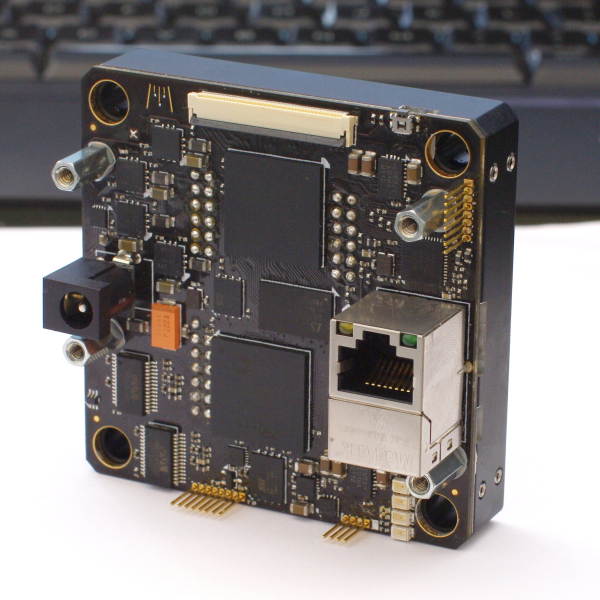|
BigCam |
|
BigCam hardware is built around an Analog Devices dual-core DSP (ADSP-BF561). The DSP was picked because it has a RISC-like 32-bit architecture, suitable for control tasks, while at the same time providing pretty good image processing performance. The 1mm-pitch, 256-ball BGA package is also rather easy to work with. The DSP has a 128MB, x32 IS42S32160C SDRAM chip running at 120MHz as its external memory, although performance critical tasks use the internal caches. The four image sensor outputs are connected to two Wolfson WM8214 16-bit imaging ADCs - since a single WM8214 can digitize at most 40M pixels per second, and the sensor has four 15MSPS outputs, two ADC had to be used. The nominal 16-bit bit depth of the ADC is not entirely correct; noise limits the resolution to roughly 12-13 bits per sample. This does not matter, however, as the image sensor itself contributes more noise than that. Sensor and ADC timings are generated by a Xilinx Spartan-6 FPGA (XC6SLX25). The FPGA is also used as a Gigabit Ethernet MAC, and can take control of the DSP's SDRAM bus for fast packet transmission. The expansion port is directly connected to one of the FPGA's I/O banks. The Ethernet PHY on BigCam is Micrel's KSZ9021RN. The 48-pin QFN package is both easy to work with and very small, and unlike other PHYs in that package, it provides a 125MHz clock output (that was used to clock the FPGA). All power supplies connected to the sensor are controlled by precision DACs. While currently they are set to fixed values (recommended by the sensor manufacturer), in the future having real-time control over the sensor voltages may allow, for instance, single-exposure HDR operation and lower noise soft pixel reset. The sensor's timing control is certainly flexible enough. Core and I/O voltages for the DSP, FPGA, SDRAM, Ethernet and ADCs are generated by Enpirion switching regulators. The BigCam PCB is very densely packed with components, and the Enpirion switchers have excellent power density - not to mention not requiring external inductors. Plus, they seem to basically work without problems in every design using internal compensation only.
The whole design fits on a 72x72mm (2.8"x2.8") 6-layer PCB, with openings for corner rods. This allows the board to use a Thorlabs LCP01 as a base and heatsink, and directly integrate with other 60mm optical cage components from Thorlabs - this includes a Nikon F compatible lens mount. The back housing is made of plastic and has been 3D-printed by Shapeways out of laser sintered black nylon.
|
(c) 2011 Stanislaw Skowronek
Contact me: skylark unaligned org (figure out where to put the @ and .)



